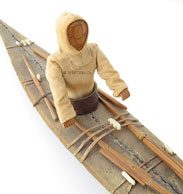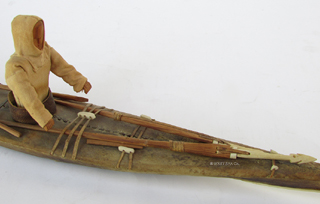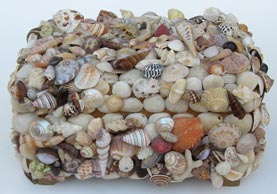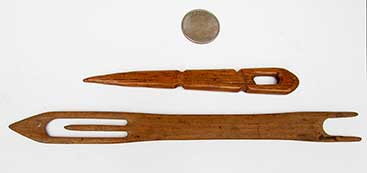West Sea
Company
OTHER NAUTICAL
Catalog Page 12

When no price is shown, use  button to request the price.
button to request the price.
Click on photos for larger images.
Click
 for ordering details.
for ordering details.
|
12.05 ESKIMO KAYAK. Very
fine early 1900’s model of an Eskimo kayak, faithfully
made in the traditional manner with seal skin over a wood
frame connected by sinew and embellished with walrus tusk
ivory components. This detailed model features a
single Eskimo hunter carved of wood, clad in coarsely-woven,
hand-stitched cloth. His handsome kayak is replete
with two long walrus ivory-tipped harpoons and two wooden
grappling tools. There are numerous other small ivory
fasteners on the top of the craft connected with
sinew. The bow and stern are further reinforced with
ivory caps and runners attached with small wooden
pins! This near scale, realistic presentation measures
20 ½ inches long by 2 3/8 inches wide. With the
Eskimo caricature it stands 3 ¾ inches high.
Outstanding original condition, beautifully preserved.
795
|
|
|
|
|
|
|
FIGURE
|
DETAIL
|
ABOVE
|
BOTTOM
|

|

|
|
12.47 LAUNCHING RELICS. Rare, early
World War II launching commemorative in the form of a
sterling silver cigarette box. This jewelry-quality box is
signed on the bottom "Shreve & Co San Francisco
Sterling." The inside of the gold-washed lid is beautifully
engraved with the presentation reading "Mrs. O.A. Mechlin,
Sponsor of "S.S. THOMAS MACDONOUGH" on January 28th 1942
Built by Oregon Shipbuilding Corporation for the United
States Maritime Commission." This wood-lined humidor is
two-tiered, separated by a glass partition. On the bottom
are shards of the original champagne bottle used in the
launching ceremony. In the top is the red, white and blue
ribbon which was tied to the bottle. Together with this
presentation is an original newspaper article dated January
29, 1942. It shows a picture of MACDONOUGH during
launch and a close-up of Mrs. Mechlin with the champagne
bottle in her hand. The caption reads, "PORTLAND Mrs. O.A.
Mechlin, wife of maritime commission's co-ordinator of plant
construction on the west coast, is shown about to christen
the new liberty ship Thomas Macdonough at launching
ceremonies at Oregon Shipbuilding corporation Wednesday. Mr.
Mechlin watches her wind up with a bottle of champagne." 9
1/2 inches long by 3 1/4 inches wide and 2 1/2 inches high.
Perfect condition.
695
The S.S. THOMAS MACDONOUGH United States Maritime
Commission hull number 179, was a Liberty Ship of 441 1/2
feet in length with a beam of 57 feet. It displaced 14,425
tons with a registered tonnage of 7176 tons. With a shaft
horsepower of 2500 its maximum speed was 11 knots.
MACDONOUGH was one of the first ships of its type,
launched just weeks after the Japanese invasion of Pearl
Harbor. It saw uneventful service as a war cargo carrier.
Put in mothballs after the war, it was eventually scrapped
in 1960.
|

|
12.04 SEA SHELL MUSIC BOX.
Really special, mid-century jewelry/music box
decorated with literally hundreds of
different and
unique sea shells from around the
world! This amazing jewelry box has a hardwood
interior lined with blue tufted satin. The hinged lid
has a mirror in the top. Two “fold-out”
compartments are fitted with hinged lids having tassel
pulls. A high quality mechanical French music player
is located on the lower right along with an additional
covered compartment. All contents are in pristine,
untouched original condition. The outside of the
box can be described as nothing short of a work of
art! Obviously entirely hand-made, it is profusely
covered with individual genuine sea shells of totally
different types, the sum of which would literally amount to
a museum-quality compendium! The top even has a real
seahorse! Only the back of the box is covered with recurring
cockle shells interspersed with a few other shells of
similar size and shape. This box measures. 9
½ inches wide by 7 inches deep and 6 1/2 inches
tall. Remarkably pristine, totally unused
condition. There is not a single loss or repair!
The music mechanism is wound from the bottom and plays the
well-known song “I Could’ve Danced All Night”
for more than a minute on a single wind. This piece is
really special. An incredible bargain at this
price!
495
|
|
|
|
|
|
|
BACK
|
PERSPECTIVE
|
INTERIOR
|
OPEN
|

12.38 LIGHTHOUSE. Impressive early 1900's
lighthouse made of solid bronze! This
unusually large example stands 17 1/2 inches tall by 8 1/2 inches
wide at the base and weighs a hefty 17 pounds. The "lantern" at the
top is removable and contains its original clear glass lens. The
sides of the lighthouse are cast in the form of bricks, beautifully
finished and retaining their original statuary bronze surface. There
are three windows and a door in the lighthouse, all hand-painted for
further realism. The massive base is cast in the form of craggy rocks
with a stairway leading to the door. The base is in its original deep
green verdigris finish which simulates sea rocks perfectly! Certainly
one of the biggest and nicest lighthouse statues we have yet seen.
695
|
|

|
|
LANTERN
|
BASE
|

|
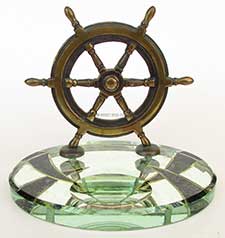
|
|
12.02 SAILOR’s VALENTINE.
Impressive, genuine 19th century shellwork
valentine of the type purchased by sailors in the Caribbean
as mementoes of their visits. This large single
valentine was once part of a double as evidenced by a key
hole for a lock. The hole was obviously filled long,
long ago and the wood had acquired a patina rendering it
practically invisible. Only the earliest of these
valentines came with locks. This particularly lovely
example has a central heart with an old fashioned anchor
above – a graphic statement of a sailor’s love
for his sweetheart. The central theme elements are
surrounded by fields of hundreds of decorative exotic shells
from those tropical waters. The octagonal Spanish
cedar case retains its original old wavy glass and is in
excellent untouched condition. 14 inches
across on the flats by 2 inches thick. A truly
exceptional example.  
Literature. John Fondas, “Sailor’s
Valentines.” 2002, Rizzoli International
Publications, New York City. Anchors depicted in shell
valentines are relatively rare. In his comprehensive
book, Mr. Fondas depicts only two examples on pages 31 and
43.
Ex. Collection Evalene Pulati, former President of the
Antique Valentine Collectors Association.
|

|
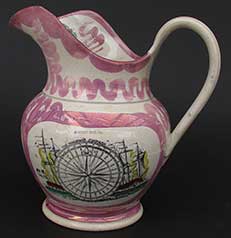
|
|
12.99 NAVAL CERAMIC. Mid
19th century or earlier earthenware plaque known as “Sunderland
Lusterware.” This classic English marine ceramic
plate features a stenciled image of an early 3-masted barque
under sail in a peaceful harbor with buildings depicted on
the shore in the background. The hard fired glazed
image is clear and bright, surrounded by the distinctive,
colorful hand-painted scalloped decorations on the rim which
made this form famous and so desirable amongst naval ceramic
collectors today. 7 ¾ inches high by 8
½ inches wide (19.4 x 21.25 cm). Absolutely
pristine original
condition.
349
Literature: D. Gordon and Margery Pugh, “Naval
Ceramics,” 1971, The Ceramic Book Company Newport,
England. Several similar wall plaques are depicted and
described in this comprehensive work. A very similar
example is shown as Plate 71C. described as “Sunderland
Pink Lusterware Wall Plaque Inscribed “Duke of
Wellington – 131 Guns,” H. 24 cm c. 1854.”
Another is shown as Plate 95A described as “Wall
Plaque Inscribed “Northumberland 74” Pink Luster
Earthenware, Sunderland 22 cm x 20 cm c.1815.”
|

|
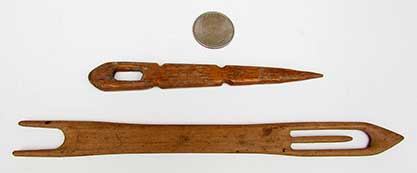
|
|
12.90 ANTIQUE SAWFISH BILL.
Interesting anatomical relic in the form of the snout of a
sawfish. This fearsome specimen has 30 razor sharp “teeth”
symmetrically spaced down the edges of the bill. The
bill itself is a thin, very stiff, leather-like extension of
the fish’s snout which was apparently used to hack and
capture prey. This example measures 18 ½ inches
long by 6 inches wide at the widest. One side is
deeply hand-carved, “KILLED – 1901.”
Very good original condition noting that two of the teeth
are chipped.
195
Unmistakably unique, the small tooth sawfish resembles
sharks in appearance but is actually a large,
bottom-dwelling ray. The name makes reference to the long,
saw-like bill, edged by numerous razor-sharp teeth.
This has been a mixed blessing for the species. The
small tooth sawfish can use its jagged snout to great
advantage to sense and capture prey. Yet its bill makes it
especially prone to capture in fishermen’s nets.
Throughout the twentieth century people killed the sawfish
as a curiosity — a novelty to be mounted on a
wall.
|

12.83 EARLY SAILOR’s KNIFE.
Classic, blunt-tipped knife as issued to and used by seamen in the
18th and 19th centuries. This nice example has “jigged”
carved wooden grips on each side, a metal bolster and a pivoting bail
on the working end. This single blade knife has a thumbnail
indent for pulling out the blade which locks into place with a sure
action. It measures 5 ¼ inches closed (inclusive of bail)
and 8 ½ inches extended. Excellent original condition with
some minor spotting on the blade, as expected of an antique knife
used in a marine environment.
49

|
|
CLOSED
|

12.79 BATTLESHIP MAINE CANDY
DISH. Very rare, genuine, late 19th century milk glass
candy dish with cover. This charming commemorative is cast with
high detail in the form of the famous Battleship Maine which blew up
in Havana Harbor on February 15, 1898. That event sparked the
Spanish-American War. The resultant outpouring of patriotism
led to a ready market for such commemoratives, and the famous slogan “Remember
the Maine.” This example, made by Atterbury later that
year, is cast in relief “MAINE” on both sides of the
bow. It measures 7 ¾ inches long, 3 ¾ inches high and
4 1/8 inches wide. It is in exceptionally fine condition for
such a fragile item of this vintage, with only a couple of very minor
fish eyes on the rim.
199
See Everett Grist, “Covered Animal Dishes,” 1987,
Collector Books, page 93. This large, covered milkglass dish is one
of the rarest.
|

|

|
|
MAINE
|
COVER
|

12.77 EARLY BOOKENDS.Matched pair,
turn-of-the-last century bookends in the unusual form of a bow-on
sailing ship.These precisely-cast sculptures are in their original
antique statuary bronze finish.The front of each bears the
inscription, "IRON BARQUE MACQUERIE" while the backs are incised with
the ship's statistics:"BUILT IN 1875. BY MESSRS R & H GREEN OF
LONDON HER REG. TONNAGE IS 1977.LENGTH. 269.8 FT.BEAM: 40.1
FT.DERTH:23.7 FT."The rear is embossed "JB 2503" indicating Jennings
Brothers Manufacturing Co. of Bridgeport, Connecticut.These handsome
bookends stand 6 1/2 inches tall, 4 inches wide, by 2 1/2 inches deep
and weigh just under 3 pounds.Outstanding original condition.A rare
pair of antique bookends made contemporaneously with the vessel they
honor.195/pr
Jennings Brothers began their manufactory in
Bridgeport, Connecticut in 1891 and continued business into the early
1900s. The company produced some of the finest crafted art metal
pieces ever made.The product line included high grade bookends,
candlesticks and figurines. Their methods were exacting and
meticulous, not lending themselves to mass production.Rather, they
relied upon the expert skills of individual artists, sculptors and
metal craftsman.Today Jennings Brothers metalwork is highly prized.
Surviving examples bearing the distinctive "JB" mark are avidly
sought after by collectors world-wide.

|

|
|
SIDES
|
BACKS
|

12.75 BOOK ENDS. Finest quality book
ends made by the prestigious firm of Bradley & Hubbard as marked
on the backs, "B&H." This matched pair is constructed of heavy
cast brass in high relief with extraordinary detail! Each depicts a
17th century galleon at sea with sails set and pennants streaming.
The vignette is encircled by an ornate "rope" border with mythical
winged dolphins of the period flanking either side. The backs feature
a hand-punched surface of the most exceptional quality. Each book end
is in its original gold finish with polished brass highlights. 2 1/2
pounds each. 6 1/2 inches tall by 4 inches wide each. Circa 1920.
Perfect original condition! 295
In 1854 Nathaniel Bradley and his brother William formed a
partnership with Walter Hubbard named Bradley and Hubbard in
the town of Meridian, Connecticut. The same company, under its
previous owners, was engaged primarily in the production of clocks.
But bells and sewing machines were added to the line through the
1860's.
During the Civil War Bradley and Hubbard expanded its
market west of the Mississippi, adding flags, hoop skirts, spring
measuring tapes and match safes to its production during the war.
With the discovery of oil in Pennsylvania in 1859 Bradley &
Hubbard decided to begin production of kerosene burning lamps. By
1871, kerosene virtually replaced whale oil for heating and
illumination. New ways of burning it more efficiently were needed.
Between 1868 and 1875 Bradley and Hubbard secured 33 patents
relating to oil-burning lamps. In 1875 the firm was reorganized and
renamed The Bradley and Hubbard Manufacturing Company.
Growing rapidly during the 1880's, the company added new products
such as architectural castings, railings, fences, window guards, and
elevator enclosures. By the 1890's the Bradley and Hubbard
name was synonymous with high quality and artistic merit.
The company continued into the early 20th century, surviving the
Great Depression. But after 88 years in business, it was sold in 1940
to the Charles Parker Company, also of Meriden.

12.71 CIGAR CUTTER/ASHTRAY. Authentic, 19th century German
figural ashtray with the dual purpose of being a cigar cutter. This
is without question the finest example of such a nautical novelty
that we have ever offered. It consists of a realistic solid brass
ship's engine order telegraph mounted to an ashtray with two supports
for lit cigars. The double sided dial of the telegraph head is marked
in relief with the standard engine orders (in German) with STOP
(HALT) marked in red. The moveable handle swings indicator arrows
over both dials while moving internal knife edges on both sides.
These were used to cut off the tips of old fashioned cigars. The
threaded removable base also acted as a repository for the tips. One
of the nicest features of this presentation is the hand-hammered
brass ashtray which exhibits hundreds of small impressions done in a
repoussé manner. 6 1/2 inches high by 6 inches wide and 5 1/2
inches from front to back. Outstanding original condition, totally
functional, and with a lovely statuary bronze age patina to all
surfaces. 495

12.67 EARLY SHIP COMMEMORATIVE.
Genuine, early 1900's framed photograph of the American steamer
identified as the S.S. STEEL WORKER. This handsome
presentation consists of a period black and white photograph of the
vessel that has been hand tinted. It is mounted under glass within a
turned redwood frame in the form of a ship's wheel. The frame is
decoratively hand-painted in a distinctive style, "S.S. STEEL WORKER"
with a fouled anchor. The image measures 5 1/2 inches in diameter
with the entire presentation being 12 inches across. Excellent
original condition.
179
The S.S. STEEL WORKER, call sign
KDBJ, was built by the Federal Shipbuilding & Drydock Co. (a
division of United States Steel) Kearney, New Jersey in 1920. She was
of 5,860 gross tons, 3,450 net tons, had a length of 424 feet, a
breadth of 56 feet and a draft of 26 1/2 feet. With a crew of 34,
S.S. STEEL WORKER operated under the ownership of the Isthmian
Steamship Company, home ported in New York.
The distinctive style and format of this
presentation is quite recognizable and has come to our attention
several times before. (See West Sea Co. items 5.13, 5.14, 5.74, 5.77
and 15.68). Although the authorship of these commemoratives is
unknown, they apparently were produced by a cottage industry in the
San Francisco Bay Area in the first quarter of the 20th century. They
are quite collectible and are still very inexpensive for what they
are -- decorative, real time ship mementoes made for the
crew!

|
|
SHIP
|

12.57 P.O.W. STRAW WORK "BOOK." Very
scarce late 18th or very early 19th century dressing/jewelry box made
in the form of a book. This cleverly constructed box, is made of wood
with all surfaces meticulously covered with split straw in a
marquetry fashion. The resulting effect is a remarkably lustrous
surface with intricate geometrical star burst, pinwheel and fan
designs. The end pages of the "book" appear to be genuine gilt paper
which have been fitted with faux drawer pull knobs made of bone.
Opening the hinged lid secured with a button latch reveals the
beautifully preserved interior fitted with a mirror and two hinged
doors covering two tills within. The entire interior is also
decorated with straw work in the same phenomenal fashion. This "book"
measures 6 1/4 inches high by 4 1/4 inches wide and 2 inches thick.
It is in an exceptionally good state of original preservation given
its great age and fragility of this medium. As is typical of such
straw work, there is evidence of wear and small losses on the
exterior. The interior is virtually perfect and original.
695

|

|

|

|

|
|
OPEN
|
INTERIOR
|
FRONT
|
TOP
|
BOTTOM
|

12.37 SHIPWRIGHT'S TOOL. Very scarce
19th century auger used in shipbuilding to drill holes in timbers for
attaching same with iron or copper spikes. This hand wrought iron and
cast steel hand drill has a one piece oak handle secured to the shaft
by means of an iron collar with thumb screws. The helical drill shaft
terminates in its original 2-bladed cutter with sharp threaded screw
tip. This drill is of a very impressive size, measuring 17 inches
wide at the handle by nearly a yard long, and is capable of cutting a
hole 1 3/8th inches in diameter! Outstanding original condition
showing good age and use with excellent old surfaces.
249

|
|
HANDLE
|

12.19 P.O.W. SNUFF BOX. Absolutely
charming late 18th or very early 19th century carved bone folk art
snuff box depicting a handsome gentleman suitor courting a lovely
maiden. This intricately constructed box is indicative of the
incredible output of French prisoners in British prisons during the
Napoleonic War era. It consists of an inner core of solid wood that
has been hollowed out. Overlaying the wood is sheathing consisting of
bovine bone attached with tiny brass pins. The box opens with fine
hand-made brass hinges and is equipped with a tiny friction latch
which allows it to close with a positive fit, assuring preservation
of its precious contents. The front of the box is engraved with the
initials "CT DW." It is both relief carved AND engraved with floral
motifs and a "brick" pattern. It measures 3 1/2 inches long by 2 1/4
inches wide and 1 1/4 inches thick. This snuff box is in an
incredible state of original preservation with no damage or repairs
whatsoever. A superbly rare example of 200 year old P.O.W.
work with a delightfully endearing subject!
1895

12.26 SCULPTURE. Genuine 19th C.
French statue of a handsome young fisherman carrying his net entitled
"PECHEUR." This spelter metal statue is mounted to its original
turned wooden base painted to resemble marble. 11 1/4 inches tall.
Good overall condition noting a small section of the wood has been
reattached. Decorative and pleasing.
199

© 1998-2014 West Sea Co. All
rights reserved.
![]() for ordering details.
for ordering details.
